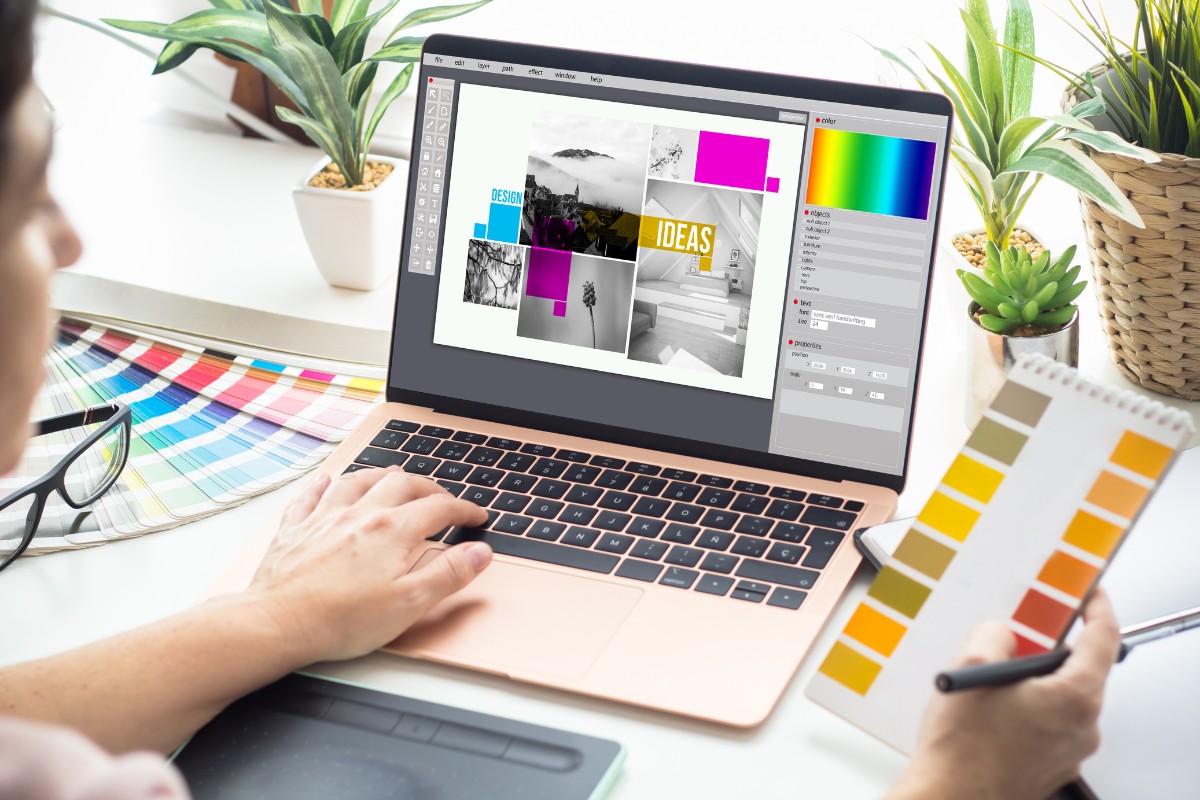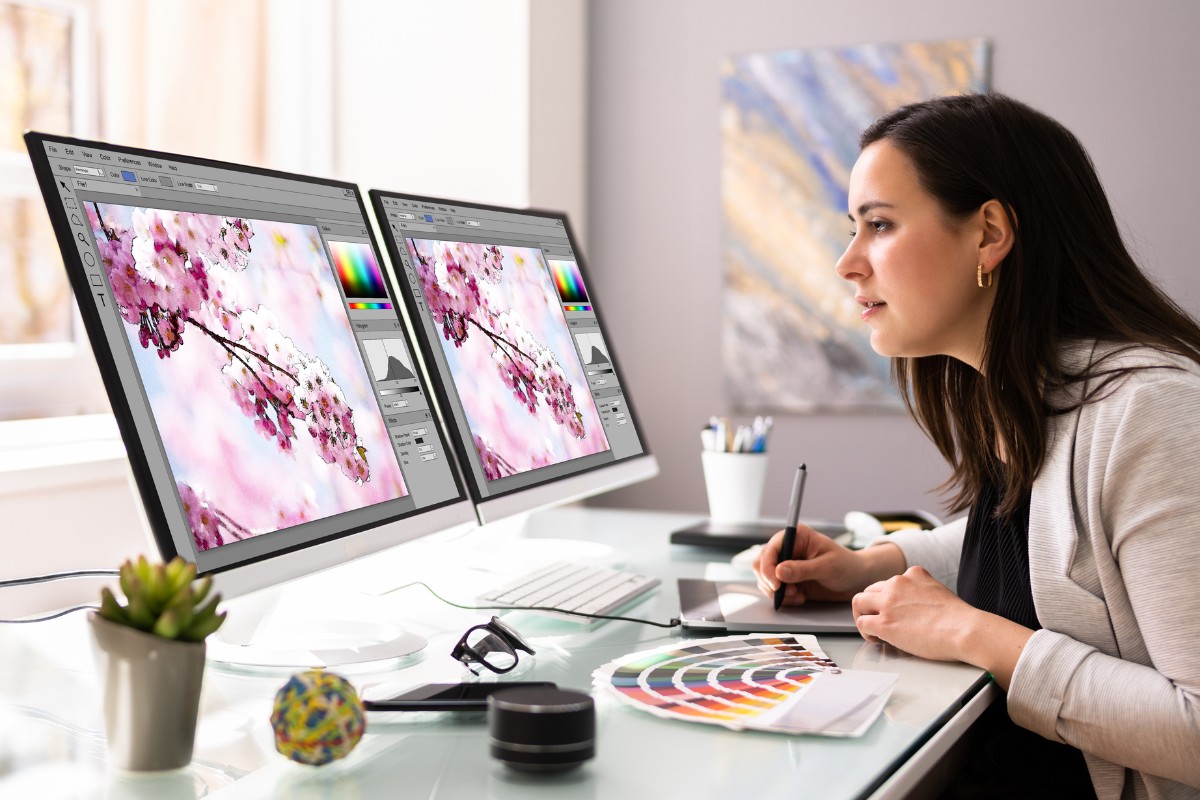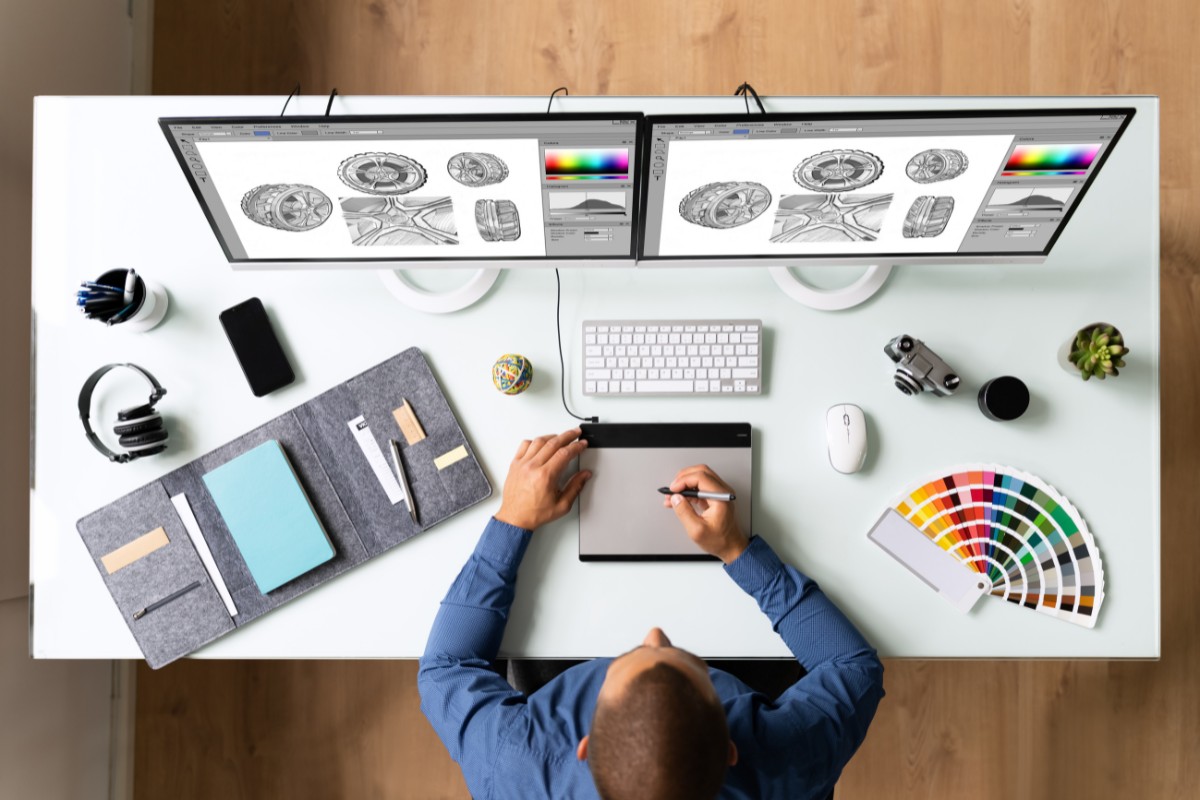Graphic design is a field that continues to grow in importance.
And it won’t stop soon.
With the world becoming more and more visually oriented, there will be an even more significant growth in the demand for talented graphic designers in the future.
There are many reasons to choose this career, but how do you do it?
This article will teach you how to become a graphic designer with the knowledge, skills, and techniques you need to become a professional and succeed in your chosen field.
Post Contents
- 1 What Is The Role Of A Graphic Designer?
- 2 How To Become A Graphic Designer
- 3 Reasons For Becoming A Graphic Designer
- 4 Frequently Asked Questions
- 5 Conclusion
What Is The Role Of A Graphic Designer?

Graphic designers are the artistic professionals behind the visual elements that surround us daily.
They are the creative minds responsible for crafting everything from captivating logos to eye-catching posters, websites that leave an impact, and the overall aesthetics of product packaging.
At its core, the role of a graphic designer is to communicate a message or an idea through visual mediums.
This involves a delicate blend of creativity, technical skill, and an acute understanding of the target audience.
Graphic designers transform concepts, ideas, and messages into visually compelling, easy-to-understand designs.
They are the bridge between creativity and communication, and their work influences our perceptions, decisions, and interactions with the world around us.
How To Become A Graphic Designer
1. Master the Basics

To embark on your journey as a graphic designer, mastering the basics is paramount.
These fundamental principles lay the groundwork for your future success in the field.
You build a solid foundation by familiarizing yourself with concepts such as color theory, typography, layout design, and visual elements.
- Color theory, for instance, allows you to understand the psychology of colors and their impact on human perception, enabling you to create designs that evoke specific emotions.
- Typography knowledge empowers you to select and arrange fonts effectively, enhancing readability and aesthetics.
- Layout design principles guide you in arranging elements within a design while understanding visual elements helps you compose balanced and visually appealing compositions.
These fundamentals are the cornerstone of your graphic design education and will be invaluable throughout your career.
2. Learn Design Software
Proficiency in design software is non-negotiable in the graphic design world.
Software tools are your brushes, and Adobe Creative Cloud, with applications like Photoshop, Illustrator, and InDesign, is the industry standard.
These tools are your primary weapons in crafting stunning visuals.
- Photoshop is your go-to for photo editing and image manipulation.
- Illustrator excels in vector graphics and illustrations, making it ideal for logos and scalable artwork.
- InDesign is the choice for layout design, whether it’s for print or digital media.
Devoting time to mastering these applications is necessary for your graphic design journey.
Thankfully, many online tutorials and courses are available to help you get started, making the learning process both accessible and rewarding.
As you gain proficiency, you’ll unlock the full potential of your creativity and design capabilities.
3. Build a Strong Educational Background
While not mandatory, a formal education in graphic design can be immensely beneficial.
Consider enrolling in a reputable design school or taking online courses to earn a degree or certificate.
It can give you the knowledge and credentials that may be advantageous in a competitive job market.
Education doesn’t stop after you earn a degree.
To excel in graphic design, you should engage in lifelong learning.
Attend workshops, webinars, and seminars to stay updated with the latest design trends and technologies because they will keep your skills relevant and in demand.
4. Crafting a Stellar Portfolio

You need to showcase your best work rather than inundating it with mediocre pieces, meaning you must curate a collection of projects highlighting your skills and versatility.
Potential clients and employers will judge your capabilities based on your portfolio.
Don’t limit your portfolio to work you’ve been paid for.
Personal projects that demonstrate your passion and creativity can be equally compelling.
These projects allow you to explore your unique style and stand out in a crowded field.
5. Gaining Practical Experience
Internships
To gain practical experience, consider internships at design agencies, studios, or companies with in-house design departments.
Internships provide you with valuable insights into the industry, and they can often lead to full-time positions.
Freelancing
Freelancing is an excellent way to build a diverse portfolio and earn income while studying or working part-time.
Websites like Upwork, Fiverr, and Freelancer offer platforms to connect with clients seeking design services.
6. Searching the Job Market

Tailor Your Resume and Cover Letter
Customize your resume and cover letter when applying for graphic design positions to match the specific job requirements.
Highlight relevant skills and experiences that demonstrate your suitability for the role.
Networking
Building a network within the design community is vital.
Attend design conferences, join online forums, and engage with fellow designers on social media platforms.
Networking can open doors to job opportunities and collaborations.
Build a Strong LinkedIn Profile
Your LinkedIn profile is essentially your online resume that can land you really good jobs.
Use a professional headshot and write a compelling headline that reflects your expertise.
Craft a well-written summary highlighting your skills, experiences, and what you’re passionate about as a graphic designer.
Remember to keep your profile updated with your latest work and accomplishments.
LinkedIn offers a variety of groups and communities centered around design.
Join these groups to connect with fellow designers, share your insights, and stay informed about industry trends.
Actively participating in discussions within these groups can help you establish your expertise.
7. Stay Inspired
Design is a dynamic field, and trends evolve rapidly.
Stay inspired by exploring the work of other designers.
Platforms like Behance, Dribble, and Pinterest are excellent sources of inspiration.
Also, analyze and deconstruct designs that captivate you to understand the techniques behind them.
8. Evolving with the Industry

Keep up with the latest tools and software.
For instance, explore 3D design, virtual reality, and augmented reality, as these are emerging trends in the field.
Client needs and preferences can vary significantly.
As a graphic designer, your ability to adapt to these changing requirements is crucial.
Effective communication and understanding of client expectations will set you apart.
Reasons For Becoming A Graphic Designer
Creative Expression
Graphic design is an art form; for many, it’s a powerful medium of creative expression.
As a graphic designer, you have the opportunity to transform ideas, concepts, and messages into captivating visuals.
It’s a space to explore your artistic side while creating meaningful and impactful designs.
Versatility
Graphic design is a versatile field that spans various industries.
Every sector requires graphic design expertise, whether it’s fashion, advertising, technology, or healthcare.
This versatility means you can work in a field that genuinely interests you or explore different niches throughout your career.
Constant Innovation
The graphic design field is far from static; It’s a space of continuous innovation and adaptation, meaning design software, trends, and technologies are ever-evolving, as we said before.
If you’re someone who thrives on staying up-to-date with the latest tools and techniques, graphic design offers a stimulating environment for personal and professional growth.
Competitive Salaries
Graphic designers can enjoy competitive salaries.
The compensation for graphic design positions varies depending on experience, location, and industry.
However, many graphic designers are well-compensated for their skills and expertise, making it an appealing career option financially.
Job Opportunities
The demand for skilled graphic designers continues to grow as large and small businesses recognize the importance of solid visual branding and marketing.
This high demand translates into many job opportunities, from in-house design positions to freelancing and agency work.
Entrepreneurial Pursuits
Many graphic designers venture into entrepreneurship, using their skills to start their own design agencies or studios.
This path offers the freedom to choose projects, clients, and creative direction, making it an attractive option for those with an entrepreneurial spirit.
Self-Fulfillment
For some, being a graphic designer isn’t just a job; it’s a source of personal fulfillment.
Seeing your creative ideas come to life and positively impact the world can be deeply rewarding.
Frequently Asked Questions
What abilities are required of a graphic designer?
Graphic designers must be proficient in design tools (e.g., Adobe Creative Cloud), have a solid understanding of design concepts, be creative, have an eye for detail, and have practical communication skills.
Furthermore, adaptability, time management, and the capacity to operate under pressure are essential.
Is formal schooling required to become a graphic designer?
While a formal degree in graphic design might be beneficial, it is not necessarily required.
Many accomplished graphic designers are self-taught or have completed online courses.
A degree or qualification might open doors to particular jobs and provide a disciplined learning environment, but a solid portfolio and abilities are typically more important.
How can I create a solid graphic design portfolio?
A solid graphic design portfolio is established by exhibiting your best work, including a mix of projects that illustrate your abilities and versatility.
Include relevant internships, professional experience, personal projects, and freelance work.
Update your portfolio regularly to reflect your most recent and most incredible work.
Conclusion
Becoming a successful graphic designer is a journey that requires dedication, creativity, and adaptability.
You need to know the steps on how to become a graphic designer first, then practice them to excel in this field.
Remember, the graphic design industry is ever-evolving, so staying updated with the latest trends and technologies is paramount to your success.






























